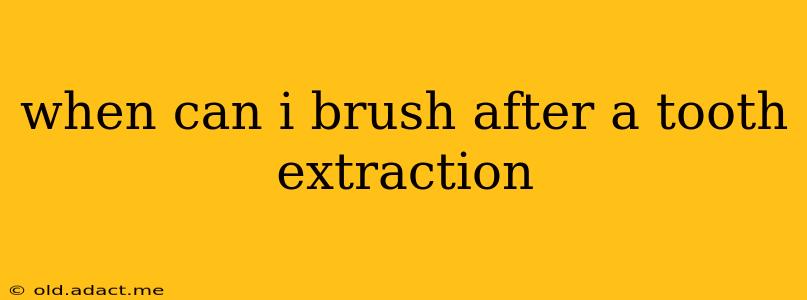Having a tooth extracted can be a disruptive experience, and knowing when it's safe to resume your normal oral hygiene routine is a common concern. Brushing your teeth is crucial for maintaining good oral health, but the delicate healing process after an extraction requires a careful approach. This guide will address your questions and help you understand the best practices for post-extraction oral care.
How Soon Can I Brush After a Tooth Extraction?
The general recommendation is to wait at least 24 hours before brushing near the extraction site. This allows the initial blood clot to form, which is essential for preventing dry socket (alveolar osteitis), a painful complication. However, you can gently brush the rest of your teeth as normal. This helps maintain overall oral hygiene and prevent infection elsewhere in your mouth.
What if I Get a Dry Socket?
A dry socket occurs when the blood clot at the extraction site dislodges prematurely. This exposes the underlying bone and nerve endings, causing severe pain and discomfort. While brushing too soon is a contributing factor, other things, such as smoking or using a straw, can also cause it. Symptoms of a dry socket include persistent throbbing pain, a bad taste in the mouth, and visible bone in the socket. If you suspect a dry socket, contact your dentist or oral surgeon immediately.
How Should I Brush After 24 Hours?
After the initial 24-hour waiting period, you can carefully resume brushing, but proceed with caution:
- Gentle Brushing: Use a soft-bristled toothbrush and brush gently around the extraction site, avoiding direct contact with the area as much as possible.
- Avoid Pressure: Don't press hard on the gums or the area around the extraction. Be extra gentle.
- Focus on Surrounding Teeth: Concentrate on cleaning the teeth adjacent to the extraction site, but keep your toothbrush away from the actual extraction socket.
What Kind of Toothbrush Should I Use?
A soft-bristled toothbrush is highly recommended after a tooth extraction. The softer bristles are less likely to irritate the sensitive gum tissue and dislodge the blood clot. Consider using an electric toothbrush with a gentle setting for added control and precision.
What About Mouthwash?
The use of mouthwash after a tooth extraction can be a bit controversial. Some dentists recommend a gentle saltwater rinse (1/2 teaspoon of salt in 8 ounces of warm water) several times a day to keep the area clean and promote healing. However, avoid using alcohol-based or harsh mouthwashes, as these can irritate the extraction site. Always check with your dentist or oral surgeon for their specific recommendations on mouthwash use.
Can I Use Floss After a Tooth Extraction?
It's generally advisable to avoid flossing near the extraction site for at least a week. Flossing in this area can disrupt the blood clot and increase the risk of dry socket. You can floss your other teeth as usual, but carefully avoid the area where the tooth was extracted.
When Can I Return to My Normal Oral Hygiene Routine?
You can usually resume your normal brushing and flossing routine after about a week or so, provided the healing is progressing well. However, it's always best to follow your dentist's or oral surgeon's specific instructions. They'll be able to assess your individual situation and provide personalized advice.
Should I See My Dentist if I Have Concerns?
It's vital to monitor the healing process closely. If you experience any significant pain, swelling, excessive bleeding, or signs of infection (such as pus or foul odor), contact your dentist or oral surgeon immediately. They can diagnose any problems promptly and provide appropriate treatment.
Remember, proper post-extraction care is crucial for a successful recovery. Following these guidelines and keeping in close communication with your dental professional will help ensure a smooth healing process.
